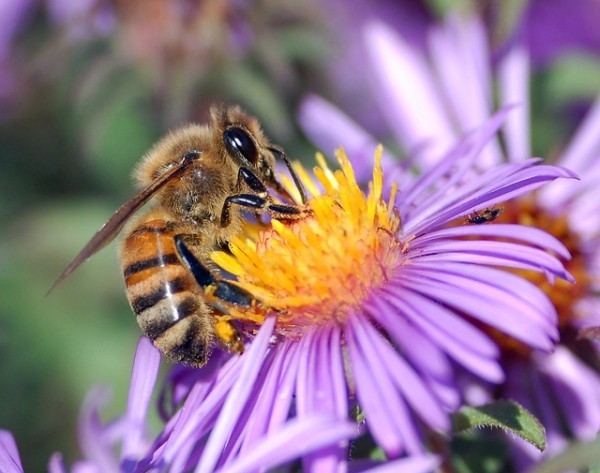Bee Colony Collapse: Population Deaths to 60% in US
| Ana Verayo | | May 14, 2015 12:13 AM EDT |
Young bees foraging for nectar.
New reports reveal an alarming rate of U.S. honeybee populations taking another devastating dive as beekeepers and the industry report of a 42 percent loss of colonies that began last month, April.
Prior to this bizarre death rate of honeybees, another 34 percent of colonies were observed to suffer during a 12 month period.
Like Us on Facebook
This mysterious colony collapse disorder first occurred around 2006 where beekeepers report of having to deal with 10 percent of bee population deaths every year.
However, for the first time ever, honeybee deaths spiked at an unprecedented rate that even exceeding deaths during winter season as experts consider this phenomenon totally shocking. Bees more commonly die during the winter amidst short food supplies and extreme temperatures.
Among the greatest that was hit by this environmental disaster were several U.S. states particularly Iowa, Maine, Illinois, Oklahoma, Pennsylvania and Wisconsin. Each of the states suffered as much as 60 percent losses among their bee colonies. Hawaii reports with the lowest annual loss of bee colonies that is down to 14 percent from data was gathered from the Bee Informed Partnership that is supported by universities and research laboratories.
This unlikely development is now destroying commercial businesses of beekeepers who solely rely on the insects to produce for their livelihood and overall agriculture. Bees are used to provide pollination services to farm industries that is estimated to be worth US $15 billion dollars every year.
Scientists are still baffled about the real cause about these honeybee die offs however theories involve toxins in pesticides and the dramatic transformation of wildflower habitat to farmland which is highly critical for bee survival.
Another theory involves invasive parasites to the species such as the varroa mite where colonies suffer from infestations. These blood sucking parasites are transmitting and aggravating the effects of a disease called deformed wing syndorme that are also plaguing U.K. honeybee hives to date.
Lately, new studies also blame a class of pesticides known as neonicotinoids that are making the bees addicted to nicotine and disabling bee colonies by making them paralyzed or unable to perform tasks, leading to beehive collapse.
These pesticides are widely used in the U.S. but three kinds were banned when it comes to flowering plants by the European Commission for the safety of the bees' survival.
Tagsbee colony collapse, bee die offs, honeybees, Bees, bee population deaths
©2015 Chinatopix All rights reserved. Do not reproduce without permission
EDITOR'S PICKS
-

Did the Trump administration just announce plans for a trade war with ‘hostile’ China and Russia?
-

US Senate passes Taiwan travel bill slammed by China
-

As Yan Sihong’s family grieves, here are other Chinese students who went missing abroad. Some have never been found
-

Beijing blasts Western critics who ‘smear China’ with the term sharp power
-

China Envoy Seeks to Defuse Tensions With U.S. as a Trade War Brews
-

Singapore's Deputy PM Provides Bitcoin Vote of Confidence Amid China's Blanket Bans
-

China warns investors over risks in overseas virtual currency trading
-

Chinese government most trustworthy: survey
-

Kashima Antlers On Course For Back-To-Back Titles
MOST POPULAR
LATEST NEWS
Zhou Yongkang: China's Former Security Chief Sentenced to Life in Prison

China's former Chief of the Ministry of Public Security, Zhou Yongkang, has been given a life sentence after he was found guilty of abusing his office, bribery and deliberately ... Full Article
TRENDING STORY

China Pork Prices Expected to Stabilize As The Supplies Recover

Elephone P9000 Smartphone is now on Sale on Amazon India

There's a Big Chance Cliffhangers Won't Still Be Resolved When Grey's Anatomy Season 13 Returns

Supreme Court Ruled on Samsung vs Apple Dispute for Patent Infringement

Microsoft Surface Pro 5 Rumors and Release Date: What is the Latest?










